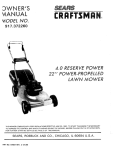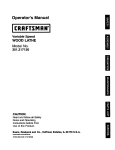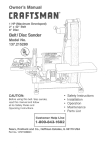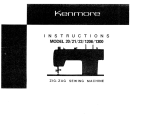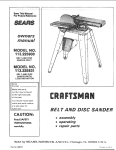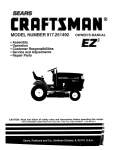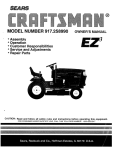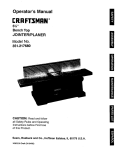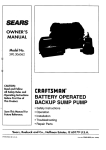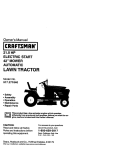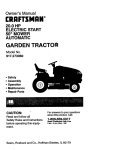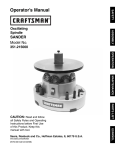Download Craftsman 351.226061 Operating instructions
Transcript
CRRFTSMRN Operator's Manualo 6 x 48" Oscillating Belt 12" Disc SANDER Model No. 351.226061 CAUTION: Read and follow all Safety Rules and Operating Instructions before First Use of this Product. Sears, Roebuck and Co., Hoffman Estates, IL 60179 U.S.A. 17985.00 Draft (01/18/02) I Warranty ....................................... • Proper electrical receptacle should be available for tool. Three prong plug should be plugged directly into properly grounded, three-prong receptacle. 2 Safety Rules .................................... Unpacking ..................................... Assembly ..................................... Installation .................................... 2 3 3-4 4-5 Operation .................................... Maintenance .................................... 5-8 8 • Extension cords should have a grounding prong and the three wires of the extension cord should be of the correct gauge. • Keep visitors at a safe distance from work area. • Keep children out of workplace. Make workshop childproof. Use padlocks, master switches or remove switch keys to prevent any unintentional use of power tools. Troubleshooting ................................. Parts illustrationand List ....................... 9 10-13 TOOL SHOULD BE MAINTAINED Espahol .................................... 14-23 • Consult manual for specific maintaining and adjusting procedures. • Always unplug tool prior to inspection. • Keep tool lubricated and clean for safest operation. • Remove adjusting tools. Form habit of checking to see that adjusting tools are removed before switching machine on. FULL ONE YEAR WARRANTY ON CRAFTSMAN BELT & DISC SANDER • Keep all parts in working order, Check to determine that the guard or other parts will operate properly and perform their intended function. if within one full year from the date of purchase, this Craftsman sander fails due to a defect in material or workmanship, Sears will repair it free of charge. Warranty service is available by contacting Sears in-home major brand repair service.This warranty gives you specific legal rights and you may also have other rights which vary from state to state. • Check for damaged parts. Check for alignment of moving parts, binding, breakage, mounting and any other condition that may affect a tool's operation. • A guard or other part that is damaged should be properly repaired or replaced. Do not perform makeshift repairs. (Use parts list provided to order replacement parts.) If this sander is used for commercial purposes, this warranty applies for only 90 days from the date of purchase. Sears, Roebuck and Co., Dept. 817WA, Hoffman Estates, IL 60179 KNOW HOW TO USE TOOL • Use right tool for job. Do not force tool or attachment to do a job for which it was not designed. • Disconnect tool when changing belt or abrasive disc. WARNING: For your own safety, read all of the instructions and precautions before operating tool. • Avoid accidental start-up. Make sure that the tool is in the "OFF" position before plugging in. CAUTION: Always follow proper operating procedures as defined in this manual even if you are familiar with use of this or similar tools. Remember that being careless for even a fraction of a second can result in severe personal injury. • Do not force tool. It will work most efficiently at the rate for which it was designed. • Keep hands away from moving parts and sanding surfaces. • Never leave tool running unattended. Turn the power off and do not leave tool until it comes to a complete stop. BE PREPARED FOR JOB • Wear proper apparel. Do not wear loose clothing, gloves, neckties, rings, bracelets or other jewelry which may get caught in moving parts of machine. • Do not overreach. Keep proper footing and balance, • Wear protective hair covering to contain long hair. • Know your tool. Learn the tool's operation, application and specific limitations. • Never stand on tool. Serious injury could occur if tool is tipped or if belt or disc are unintentionally contacted. • Wear safety shoes with non-slip soles, • Use recommended accessories (refer to page 11). Use of improper accessories may cause risk of injury to persons. • Wear safety glasses complying with United States ANSI Z87.1. Everyday glasses have only impact resistant lenses. They are NOT safety glasses. • Handle the workpiece correctly. Protect hands from possible injury. • Wear face mask or dust mask if operation is dusty. • Turn machine off if it jams. Belt jams when it digs too deeply into workpiece. (Motor force keeps it stuck in the work.) • Support workpiece with miter gauge, belt platen or work table. • Be alert and think clearly. Never operate power tools when tired, intoxicated or when taking medications that cause drowsiness. PREPARE WORK AREA FOR JOB • Keep work area clean. Cluttered work areas invite accidents. • Maintain Y,," maximum clearance between table and sanding belt or disc. • Do not use power tools in dangerous environments. Do not use power tools in damp or wet locations. Do not expose power tools to rain. CAUTION: Think safety! Safety is a combination of operator common sense and alertness at all times when tool is being used. • Work area should be properly lighted. WARNING: Do not attempt to operate tool until it is completely assembled according to the instructions. 2 ATTACH FOOT RESTS Refer to Figure 12. Required parts and hardware: • Four foot rests with bolts • Eight 5/1o" flat washers • Four s/_+"-18Hex nuts Refer to Figure 1. Check for shipping damage. If damage has occurred, a claim must be filled with carrier. Check for completeness. Immediately report missing parts to dealer. CAUTION: Sander with cabinet weighs approximately200 Ibs. At least two people are required to attach foot rests. The sander comes assembled as one unit. Additional parts which need to be fastened to sander, should be located and accounted for before assembling. A Abrasive disc B Belt table with trunnion • Carefully tip the sander to raise cabinet from the floor just enough so that one foot rest with bolt and washer (Key Nos. 3, 4 and 5) can be positioned under the cabinet corner so that the bolt slides through the hole on the cabinet base. Slowly set the sander back to the floor. Repeat three more times to position one foot rest with bolt, under each cabinet corner. C Miter gauge assembly D Two handles E Workstop Parts bag includes: 8mm flat washer, eight '/_," flat washers, four '/,,"-18 hex nuts and four foot rests with bolts. • Loosen knob (Key No. 7) and open cabinet door (Key No. 8). • Using the cabinet door opening, secure foot rests to cabinet using four fiat washers and four hex nuts (Key Nos. 2 and 3). • Make sure all the hex nuts are tight. • Close cabinet door and secure it with knob (Key No. 7). ATTACH BELT TABLE Refer to Figures 2 and 11. Required parts and hardware: • Belt table with trunnion • Handle • 8mm Flat washer Figure 1 - UnpackingSander • Position belt table (Key No. 63) on the belt housing (Key No. 48) so that the trunnion (Key No. 18) trave(s on the slide (Key No. 20). CAUTION: Do not attempt assembly if parts are missing. Use this manual to order replacement parts. • Set the belt table position so that the 0° mark on the trunnion is aligned with the pointer (Key No. 54). • Secure belt table position usingthe handle and flat washer (Key Hoe. 10 and 16). Tighten handle into the threaded hole on the belt housing. Before sander is assembled, a suitable location should be chosen. The sander with cabinet weighs approximately 200 Ibs when completely assembled. They should be assembled on location. • Sander needs to be set on a flat, level surface. • Make sure there is ample room for moving the workpiece through the entire cut. There must be enough room that neither the operator nor the bystanders will have to stand in line while using the tool. ]elt Tension Handle • Good lighting and correct power supply are also required for a proper work area. ,_1.-Table ADJUST BELT HOUSING TO VERTICAL Look Handle POSITION Refer to Figures 11 and 12, pages 10 and 12. Figure 2 - Attach Belt Table • Loosen one hex nut (Figure lt, Key No. 38) on the belt housing casting (Figure t 1, Key No. 48). Do not take out hex nut. • Sander is shipped with the belt tension handle (Key No. 52) at the released position. Pull down the handle toward the belt table to tension the belt. • Move to the rear of the sander and gently lift the belt housing up supporting the housing from both sides. • Make sure that the clearance between the belt and belt table does not exceed _/1,". • Lift belt housing until it is adjusted to the vertical position. • Wear protective glove and manually push the belt to verify that belt travels smoothly and without interference. • Tighten one hex nut (Figure 11, Key No. 38) from the rear of the sander. POSITION • Move to the front of the sander; loosen and remove three knobs (Figure 12, Key Noe. 7 and 27). DISC TABLE Refer to Figure 11. • Remove dust hood (Figure 12, Key No. 28). Required part: Handle • Tighten hex nut (Figure 11, Key No, 38). • Sander is shipped with the disc table (Key No. 24) attached to the disc guard (Key No. 11) usinga handle with flat washer one side and a hex head bolt with flat washer on the other side. • Replace dust hood and tighten knobs, 3 I H • Loosen and remove hex head bolt and flat washer from the disc table. NOTE: Though the motor works at 115/230-volt AC, sander must be operated at 115 volts only. • Replace hex head bolt with the handle provided. Secure disc table to disc guard using the handle and flat washer. Horsepower (Maximum Developed) ................... ATTACH ABRASIVE DISCTO ALUMINUM DISC Refer to Figures 3, 4 and 11. • Sander is shipped with the abrasive (Key No. 5) not applied to the aluminum disc (Key No. 1). Amperes ...................................... 3 15 Frequency.................................. 60 HZ Phase ..................................... RPM ....................................... Single 3450 Prewired .................................... 115V • Clean the aluminum disc if necessary, priorto applying the abrasive. WARNING: All electrical connections must be performed by a qualified electrician. • Remove the adhesive cover from the back of the abrasive disc. WARNING: Do not connect sander to the power source until all assembly steps have been completed. • Slide the abrasive between the disc table and aluminum disc and center abrasive on the aluminum disc. POWER SOURCE • Apply pressure on abrasive to paste. • Make sure abrasive is pasted evenly on the aluminum disc. The motor is designed for operation on the voltage and frequency specified. Normal loads will be handled safely on voltages not more than 10% above or below specified voltage. Running the unit on voltages which are not within the range may cause overheating and motor burn-out. Heavy loads require that the voltage at motor terminals be no less than the voltage specified on nameplate. • Power supply to the motor is controlled by a single pole locking rocker switch. Remove the key to prevent unauthorized use. Figure 3 - Attach Abrasive Disc GROUNDING • Make sure that the clearance between disc table and abrasive disc does not exceed '/_". WARNING: Improper connection of equipment grounding conductor can result in the risk of electrical shock. Equipment should be grounded while in use to protect operator from electrical shock. INSTRUCTIONS • Check with a qualified electrician if grounding instructions are not understood or if in doubt as to whether the tool is properly grounded. • This tool is equipped with an approved 3-conductor cord rated at 240V and a 3-prong grounding type plug rated at 125V (Figure 5) for your protection against shock hazards. Figure 4 - Check DlscTable • Use a straight edge or square to check if the disc table is at right angle to the disc. • Grounding plug should be plugged directly into a properly Lnstailedand grounded 3-preng grounding-type receptacle, as shown (Figure 5). Properly Grounded Outlet ---_,_ Grounding Prong • Wear a protective glove and manually turn the disc to verify that the disc turns freely and without interference. ATTACH MITER GAUGE Refer to Figure 11. 3-Prong Plug __ Figure 5 - 3.Prong Receptacle Required part: Miter gauge assembly • Miter gauge is shipped completely assembled (Key No. 9) and can be used with the belt or disc tables (Key Nos. 63 and 24). • Do not remove or alter grounding prong in any manner. In the event of a malfunction or breakdown, grounding provides a path of least resistance for electrical shock. • Slide miter gauge bar (Key No. 76) into the slot on belt or disc table. WARNING: Do not permLt fingers to touch the terminals of plug when installing or removing from outlet. Refer to Figures 5, 6, and 7, pages 4-5. • Plug must be plugged into matching outlet that is properly installed and grounded in accordance with all local codes and ordinances. Do not modify plug provided. If it will not fit in outlet, have proper outlet installed by a qualified electrician. Sander comes with the motor and wiring installed. The 115/230-volt AC universal motor has the following specifications. • Inspect tool cords periodically, and if damaged, have repaired by an authorized service facility. • Green (orgreenandyellow) conductor incordisthe grounding wire.If repair orreplacement oftheelectric cord orplugisnecessary, donotconnect thegreen(orgreen andyellow) wiretoa liveterminal. Motor and wires are installed as shown in wiring diagram (See Figure 7). Motor is assembled with approved, 3-conductor cord to be used at 115/230 volts. Motor is prewired at the factory for 115 volts. R E • Where a 2-prong wall receptacle is encountered, it must be replaced with a properly grounded 3-prong receptacle installed in accordance with National Electric Code and local codes and ordinances. WARNING: electrician. This work should be performed by a qualified A temporary 3-prong to 2-prong grounding adapter (see Figure 6) is available for connecting plugs to a two pole outlet if it is properly grounded. Grounding Lug Make Sure Th,s ,s Adapter 3-Prong Plug_ Switch Cord _ Connected _ I"_-" II To A Known Ground 115V Power 2-Prong Receptacle Black • Do not use a 3-prong to 2-prong grounding adapter unless permitted by local and national codes and ordinances. Black Figure 7-Wiring (A 3-prong to 2-prong grounding adapter is not permitted in Canada.) Where permitted, the rigid green tab or terminal on the side of the adapter must be securely connected to a permanent electrical ground such as a properly grounded water pipe, a properly grounded outlet box or a properly grounded wire system. Use the table to determine the minimum wire size (A.W.G.) extension cord. Yellow SchemaUc Refer to Figures 8, 9, 10, 11 and 12, pages 6, 7, 10 and 12. • Use only 3-wire extension cords having 3-prong grounding type plugs and 3-pole receptacles which accept the tool plug. DESCRIPTION Craftsman 6" Oscillating Belt and 12" Disc Sander with cabinet is constructed of rugged cast iron and heavy gauge steel providing stability and vibration-free operation. The 6 x 48" belt and 12" diameter disc are used to sand, deburr, bevel and grind large workpieces of wood, plastic and metal. • If the extension cord is worn, cut, or damaged in any way, replace it immediately. A.W,G. The 6 x 48" belt housing can be pivoted from vertical to horizontal for sanding large, straight workpieces. The belt assembly includes a tilting cast iron table that tilts 45 °, miter gauge and 4" dust collection chute. The belt oscillates right and left to reduce heat build-up and extend belt life. The 12" diameter disc can be used to sand or bevel surfaces with the use of a cast iron table that tilts out 45 ° and in 20 °, miter gauge slot and 4" dust collection chute. 14 12 NOTE: Using extension cords over 100 ft. long is not recommended. ELECTRICAL Red White I Sander also has a thermal overload protector to prevent damage to motor and other electrical components. The thermal overload protector will get activated when high temperature conditions are observed while operating the tool, This will turn the tool offto prevent temperature buildup. If that occurs, give adequate time for the sander to cool down and depress the reset button once. The tool will be ready to operate. EXTENSION CORDS Upto50 ft ..................................... 50 -100 ft...................................... \ • Remove the key from the locking rockerto prevent unauthorized use of the tool. To replace the key, press key into the slot on the locking rocker. Many cover plate screws, water pipes and outlet boxes are not properly grounded. To ensure proper ground, grounding means must be tested by a qualified electrician. Extension Cord Length Wire Size .................................. Green Sander has a locking rocker switch with removable key for safe and easy operation. • The use of any extension cord will cause some drop in voltage and loss of power. • Wires of the extension cord must be of sufficient size to carry the current and maintain adequate voltage. • White \ Figure 6 - 2-Prong Receptacle with Adapter • Line _L.....'/Co rd Motor Cord CONNECTIONS WARNING: All electrical connections must be performed by a qualified electrician. WARNING: Make sure tool is off and disconnected from power source while motor is mounted, connected, reconnected or any time wiring is inspected. The 3" diameter idler drum permits the sanding of contoured shapes and finishes by positioning the adjustable platen from a horizontal to vertical position. 5 The two dust collection chutes accept the standard 4" dust collection hose for quick removal of dust. The adjustable miter gauge can be used on both the belt and disc tables for guiding the workpiece at a desired angle while sanding. • Replace abrasives when they become loaded (glazed) or frayed. SPECIFICATIONS • Never attempt wet sanding. If the workpiece becomes too hot to handle, cool it in water. Belt size ............................ Belt platen area .......................... Belt table dimensions ....................... Belt table tilts ........................... 6 x 48", 100 grit 6% x 167/8" 6 x 10W' -20° to +45 ° Belt dust chute diameter .......................... Belt speed .............................. 4" 1570 FPM Disc diameter .......................... Disc table dimensions ........................ 0 to 45° outward 0 to 20 ° inward 4" Disc speed .............................. Base dimensions .................... 2000 RPM 231/2x 21 x 551/2" Motor ................ .................................. 197 Ibs WARNING: Operation of any power tool can result in foreign objects being thrown into eyes which can result in severe eye damage. Always wear safety goggles complying with United States ANSI Z87.1 (shown on package) before commencing power tool operation. Safety goggles are available at Sears retail stores or catalog. SAFETY BELT TABLE Refer to Figures 8 and 11. The belt table (Key No. 63) can be tilted from -20 ° to +45 °.To adjust belt table position: • Unlock the handle (Key No. 16) on the right side of table. _.=_.../Table Lock Handle 120 Volts, SP, Locking rocker 3HP (max. developed) 3450 RPM 115V, 15 AMPS Weight .................................... CAUTION: POSITION 12", 100 grit 7 x 16" Disc table tilts ....................... .................................. Disc dust chute diameter .......................... Switch ................... • When grinding metal, move workpiece across abrasive to prevent heat built up. Always observe the following safety precautions. PRECAUTIONS • Whenever adjusting or replacing any parts on the tool, turn switch OFF and remove the plug from power source. • Recheck table handles. They must be tightened securely. • Make sure all guards are properly attached. All guards should be securely fastened. • Make sure all moving parts are free and clear of any interference. • Make sure all fasteners are tight and have not vibrated loose. • With power disconnected, test operation by hand to verify clearance and adjust if necessary. • Always wear eye protection or face shield. • Make sure abrasive belt tracks properly. Correct tracking gives optimum performance. • After turning switch on, always allow belt to come up to full speed before sanding or grinding. • Be sure motor runs clockwise on disc side. Abrasive belt must travel down. • Keep your hands clear of abrasive belt, disc and all moving parts. • For optimum performance, do not stall motor or reduce speed. Do not force the work into the abrasive. • Support workpiece with belt table when sanding with belt, with disc table when sanding with disc. • Never push a sharp corner of the workpiece rapidly against belt or disc. Abrasive backing may tear. Figure 8 - Attach BeltTable /_, • Set the belt table to any angle between -20° and +45" using the scale. • Lock the handle to secure belt table position. WORK STOP Refer to Figure 11. The work stop (Key No. 31) can be used instead of the belt table. • Remove belt table from the belt housing (Key No. 48) by loosening and removing handle (Key No. 16). • Mount workstop using bolt (Key No. 30) and washer (Key No. 13) which are located on belt housing. ADJUSTING BELT HOUSING Refer to Figures 9, 11 and 12. The belt housing (Figure 11, Key No. 48) can be positionedat a full vertical position,a full horizontal position, or at any angle in between which is convenientfor the sanding operation. To adjust belt housing position: • Loosen and remove three knobs (Figure 12, Key Nos. 7 and 27). • Remove dust hood (Figure 12, Key No. 28). • Loosen hex nut (Figure 11, Key No. 36). • Move to the rear of the sander. • Loosen hex nut (Figure lt, Key No. 38) below the belt cover (Figure 11, Key No. 49). • Gently push belt housing to move to the desired angle using the scale. • A positive stop bolt (Figure 12, Key No. 30) is provided to stop the belt housing at the full horizontal position. • Tighten both hex nuts (Figure 11, Key No. 38) to secure belt housing position. • Replace dust hood using the knobs. HORIZONTAL BELT SANDING BELT TRACKING Refer to Figures 9 and 11. Refer to Figures 10 and 11. • Adjust the belt housing to full horizontal position as described in the above section, "Adjusting Belt Housing". Belt (Key No. 25) should oscillate around center on drive and idler drums (Key Nos. 36 and 65). The sander is shipped with the tracking mechanism properly adjusted. However, if adjustment is necessary: • Remove the belt table by removing handle (Key No. 16). • Install work stop as described in "Work Stop", page 6. • Loosen two knobs (Key No. 45) on either side of belt housing (Key No. 48). • Turn the unit on. • Insert a %" or 5/,, hex wrench into the hole on adjusting nut (Key No. 55) on either side. / Figure 9 - Horizontal Belt Banding • Idler drum (Key No. 65) can be used as a contact drum to sand curved surfaces. ABRASIVE BELT FINISHING Figure 1O - Belt Tracking • Finishing flat surfaces: Hold workpiece firmly with both hands; keep fingers away from abrasive belt. • Turn the adjusting nut to the right to move belt toward you or turn the adjusting nut to the left to move belt away from you. • Turn the unit off. Use work stop. Work stop is used to position and secure work being sanded. Keep end butted against work stop and move work evenly across abrasive belt. Use extra caution when finishing very thin pieces. • Replace and tighten knobs on either side of belt housing to secure tracking adjustment. Finishing long pieces: remove work stop. Apply only enough pressure to allow abrasive belt to remove material. • Finishing curved edges: Finish outside curves on flat portion of abrasive belt. Finish inside curves on idler drum portion of abrasive belt. REPLACING BELT • Finishing end grain: It is more convenient to finish ends of long workpieces with the abrasive belt in a vertical position. • For accuracy use miter gauge. • Push up the belt tension handle (Key No, 52) to release belt tension. Refer to Figures 10 and 11. • Sanding belt must be replaced when worn, torn, or glazed. • Loosen and remove four knobs (Key No. 51) from the rear of the sander. • Adjust belt table angle for beveled work. • Belt oscillation may be stopped by pulling on black washer on gearbox assembly. Press in on washer to restart oscillation. Do not ajdust belt tracking with oscillation stopped. • Remove belt cover (Key No. 49). USING MITER GAUGE NOTE: There may be an arrow on the inside of the belt.The arrow should point down toward the belt table to ensure that the splice in the belt will not come apart. • Slide old belt off the drive and idler drums (Key Nos. 36 and 65). Refer to Figure 11. • The miter gauge is used on either the disc or belt table. Use the miter gauge for securing the work and holding the proper angle while sanding. • Slide new belt over the drive and idler drums; center belt on drums. • Push the belt tension handle toward the drive drum to tension belt. • Adjust angle by repositioning the miter gauge (Key No. 79). Loosen the knob (Key No. 66) to reposition miter gauge. • Tighten the knob to secure miter gauge position. • Replace belt cover using knobs (Key No. 51). • Miter gauge assembly has a positive stop set-up for 90° and 45 ° on either side. • Wear a protective glove and manually rotate the belt by hand to check tracking. If tracking needs to be adjusted, follow steps described in "Belt Tracking". • To use the positivestop, loosen the knob, retract the indexing pin (Key No. 75) gently, turn the miter gauge slightly, slide in indexing pin and turn the miter gauge until the edge of the screw (Key No. 77) is stopped by the indexing pin. POSITION DISC TABLE Refer to Figure 11. • Disc table (Key No. 24) is adjustable from O° to 45 ° outward and O° to 20° inward. • Check accuracy of miter gauge scale (Key No. 72), • Use a combination square to adjust miter gauge square to disc. Scale should be at zero. Loosen screw (Key No. 70) and reposition scale if necessary. • To adjust the disc table position, loosen the two handles (Key No. 16) from either side of the disc table. 7 • Use the scale on disc table trunnions to set table at the desired angle. • Loosen and remove knob (Figure 12, Key No. 7) from cabinet door assembly (Figure 12, Key No. 8). • Secure disc table position by tightening the two handles. • Open cabinet door. ABRASIVE • Turn knob (Figure 12, Key No. 7) on bracket (Figure 12, Key No. 17) to release tension on V-belt (Figure 1f, Key No. 6). DISC FINISHING • Abrasive disc sanding is well suited for finishing small flat surfaces and convex edges. • Replace V-belt. Use parts list to order the appropriate Vbelt. • Move workpiece across down side (right) of abrasive disc, • Abrasive disc moves fastest and removes more material at outer edge. • Tighten knob on bracket to tension the V-belt. • Do not over tension the V-belt. Excessive tension on V-belt will reduce life of the belt and function of the tool A belt is properly tensioned when light pressure applied to midpoint of the belt produces about %" deflection. • Close the cabinet door and secure it with the knob. • For accuracy, use miter gauge. REPLACING ABRASIVE DISC Refer to Figures 11 and 12. • Loosen and remove four bolts (Figure 11, Key No. 4) from disc cover plate (Figure 11, Key No. 3). • Replace aluminum disc and secure it by tightening the set screw. • Loosen two top bolts (Figure 12, Key No. 22) from dust collection port (Figure 12, Key No. 21). • Replace dust collection port and disc cover plate and secure it with bolts. • Remove disc cover plate. • Remove old abrasive by peeling it from the aluminum disc. Removing aluminum disc is not necessary. • Replace disc table onto the disc guard and secure it using the two handles. • Clean aluminum disc if necessary. Select the proper abrasive disc and apply to aluminum disc. CLEANING Keep machine and workshop clean. Do not allow sawdust to accumulate on the tool. Keep the drums clean. Dirt on drums will cause poor tracking and belt slippage. Operate tool with dust collector to keep dust from accumulating. WARNING: After sanding wood or nonmetallic material, always clean dust collector and guards of sawdust before gdnding metal. Sparks could ignite debris and cause a fire. • Additional abrasive discs are available (See Recommended Accessories, page 11). • Replace disc cover plate • Tighten bolts on dust collection port. • Replace four bolts to secure disc cover plate. Be certain motor is kept clean and is frequently vacuumed free of dust. WARNING: Make certain that the unit is disconnected from power source before attempting to service or remove any component, Use soap and water to clean painted parts, rubber parts and plastic guards. REPLACING The shielded ball bearings in this tool are permanently lubricated at the factory. They require no further lubrication. LUBRICATION V-BELT Refer to Figures 11 and 12. • When operation seems stiff, a light coat of automobile-type wax applied to the belt and disc tables will make it easier to feed the work while finishing. • Turn sander off and disconnect it from power source. • Loosen and remove two handles (Figure 11, Key No. 16) from either side of the disc table (Figure 11, Key No. 24). • Do not apply wax to the belt platen. Belt could pick up wax and deposit it on the drums causing belt to slip. • Slide out disc table from the disc guard (Figure 11, Key No. 11). • Periodically use a grease gun to add grease to gearbox assembly through grease nipple. • Loosen the set screw (Figure 11, Key No. 2) securing the aluminum disc (Figure 1t, Key No. 1). Use the hole on the top of disc guard to locate and loosen set screw. Do not remove set screw. KEEP TOOL IN REPAIR • If power cord is worn, cut, or damaged in any way, have it replaced immediately. • Loosen and remove four bolts (Figure 11, Key No. 4) from disc cover plate. • Replace worn abrasives when needed. • Loosen and remove four bolts (Figure 12, Key No. 22) from dust collection port (Figure 12, Key No. 21). • Remove disc cover plate and dust collection port. • Slide out and remove aluminum disc. • Replace any damaged or missing parts. Use parts list to order parts. Any attempt to repair motor may create a hazard unless repair is done by a qualified service technician. Repair service is available at your nearest Sears store. 8 SYMPTOM POSSIBLE Motor will not start 1, Low voltage 2. Open circuit in motor or loose connections 3. Thermal overload protector activated 1. Check power line for proper voltage 2. inspect all lead connections on motor for loose or open connection 2, Push thermal overload button to reset Motor will not start; fuses blown or circuit breakers are tripped 1, Short cimuit in line cord or plug 1. Inspect line cord or plug for damaged insulation and shorted wires 2. Short circuit in motor or loose connections 3. Incorrectfuses or circuit breakers in power line 4, Thermal overload protector activated 2. Inspect all lead connections on motor for loose or shorted terminals or worn insulation on wires 3. Install correct fuses or circuit breakers Motor fails to develop full power (power output of 1. Power line overloaded with lights, appliances and other motors 1. Reduce the load on the power line motor decreases rapidly with decrease in voltage at motor terminals) 2. Undersize wires or circuits too long 3. General overloading of power company's facilities 2. Increase wire sizes, or reduce length of wiring 3. Request a voltage check from the power company 4. V-belt tension not correct 4. Replace V-belt !Motor overheats CAUSE(S) CORRECTIVE ACTION 4. Push thermal overload button to reset 1. Motor overloaded 1. Reduce load on motor 2. V-belt tension not correct 2. Replace V-belt Motor stalls (resulting in blown 1. Short circuit in motor or loose connections 1. Inspect connections in motor for loose or shorted terminals or worn insulation on lead wires. fuses or tripped circuit breakers) 2. Low voltage 3. tncorrect fuses or circuit breakers in power line 4. Motor overload 2. Correct the low line voltage conditions 3. Install correct fuses or circuit breakers Machine slows down while operating Applying too much pressure to workpiece Ease up on pressure Abrasive belt runs off top wheel Not tracking properly See operation, "Belt Tracking" 4. Reduce load on motor Model 351.226061 Figure 11 - Replacement Parts Illustration / for Sander 25 37 59 39 \ 40 2_ 26 t 52 5O 44 23 44 50 10\ 16.,-_ \ 15 \ 3 j9 23 10 KEY NO. PART NO. DESCRIPTION 1 2 3 4 5 6 7 8 9 10 11 12 13 14 15 16 17 18 19 20 21 22 23 24 25 26 27 28 29 3O 31 32 33 34 35 36 37 38 39 4O 41 42 43 44 45 46 47 48 02225.00 STD503103 02226.01 03333.00 02227.00 STD304340 02228.00 STD502503 08257.00 07296.00 03040.01 01201.00 STD551031 STD651131 04020.00 03041.00 00558.00 03042.00 03043.00 03044.00 03045.00 STD5511t0 03046.00 03047.00 9-28015 04867.00 03049.00 03074.00 03050.01 04020.00 03051.01 STD582066 03053.00 03054.00 STD315535 03056.00 06741.00 STD541031 04868.00 17984.00 17973.00 02644.00 17971.00 STD582043 03059.00 STD851006 STD315215 17983.00 Aluminum Disc Y,s-18x 3/e"Set Screw* Disc Cover Plate #10-24 x %" Socket Head Bolt 12" Abrasive Disc A32 V-Belt* Pulley 1_-20 x %" Set Screw* Miter Gauge Assembly (66-79) 8 x 30 x 3ram Flat washer Disc Guard 4 x 16mm Spring Pin %6"Flat Washer* %" Lock Washer* 5/,6-18x 1" Socket Head Bolt Handle Assembly Y.6" Flat Washer Trunnion Rivet Slide Pointer #10 Lock Washer* Angle Label Disc Table Abrasive Belt Y16-18x 1_" Carriage Bolt Bolt Liner Idler Drum Shaft Pivot Bracket 5/,6-18x 1" Socket Head Bolt Work Stop 3AM1-17 Retaining Ring* Snap Ring Ball Bearing Bail Bearing 6003ZZ* Drive Drum Y16-18x ¾" Set Screw 5/_-18" Hex Nut* 5 x 5 x 65mm Key Drive Shaft Guard #10-24 x 2_/_ " Pan Head Screw '/4-20x 2" Set Screw 3AM1-12 Retaining Ring* Knob 6mm Flat Washer* Ball Bearing 620177* Belt Housing Standardhardwareitem Notshown QTY 1 1 1 6 1 1 1 2 1 7 1 6 9 2 9 3 2 3 3 3 1 2 2 1 1 2 1 1 1 4 1 1 1 1 1 1 2 2 1 1 1 1 1 9 2 2 3 1 availablelocally KEY NO. PART NO. DESCRIPTION 49 50 51 52 53 54 55 56 57 58 59 60 61 62 63 64 65 66 67 68 69 70 71 72 73 74 75 76 77 78 79 80 81 82 83 84 85 86 87 88 89 9O 91 92 93 94 A 03062,00 03063.00 02303.00 17960.00 03065.00 03066.00 03067.00 03068.00 01395.00 STD541025 STD551125 04869.00 17961.00 03071.00 03072.00 03073.00 08400.00 08252.00 STD551025 01370.00 08255.00 STD511002 STD551010 08254.00 08253.00 05991.00 08256.00 03075.00 STD511007 STD541010 08251.00 17978.00 17962,00 17963.00 17964.00 05763.00 17965.00 10372.00 17966.00 06045.00 17967.00 17968.00 03089.00 17969.00 17970.00 17972.00 17985.00 Belt Cover Cam Knob Belt Tension Handle Knob Pointer QTY. Adjusting Nut Spring _/.x 20 x 1" Set Screw W'-20 Hex Nut* W' Lock Washer* 5-0.8 x 6ram Set Screw Right Adjusting Bar Left Adjusting Bar Belt Table Drum Cap Idler Drum Knob ¼" Flat Washer* #10 Fiber Washer Threaded Pin #10-24 x ¼" Pan Head Screw* #10 Flat Washer* Scale Indicator #10-24 x V2" Flat Head Screw Indexing Pin Miter Gauge Bar #10-24 x _" Pan Head Screw* #10-24 Hex Nut* Miter Gauge 11.0 x 2.4mm O-Ring Gear Shaft Gearbox Assembly 5-0.8 x 12ram Washer Head Screw Grease Nipple Crank 4-1.6 x 12mm Threadforming Screw Guide Block 5-0.8 x 20mm Socket Head Bolt Bracket 6-1.0 x 8mm Hex Head Bolt #10-24 x Y2"Socket Head Bolt #10-24 Fibre Hex Nut Rod End Connecting Rod Operator's Manual Recommended Accessories 11 A Abrasive Belts 6 x 48" (Fine) 120 Grit 9-28014 A Abrasive Belts 6 x 48" (Coarse) 50 Grit 9-28016 A Abrasive Cleaner 9-22744 1 2 4 1 1 1 2 2 2 5 3 1 1 1 1 2 1 1 1 1 1 1 1 1 1 2 1 1 3 3 1 1 1 1 3 1 1 1 1 3 2 2 1 1 1 1 1 Model 351.226061 Figure 12 - Replacement _/7 Parts Illustration for Cabinet 27 I 19 i 17 16 12 KEY NO. PART NO. DESCRIPTION 1 3076.01 Cabinet 1 2 STD541031 8 3 STD551031 "A6"-18 Hex Nut* 5A_"Fiat Washer* 4 8879.00 Foot Rest 5 STD523110 1413.00 5/,,-18 x 1" Hex Head Bolt* 4 8 Strain Relief 3 3314.00 Knob 4 Cabinet Door Assembly 9 3077.01 STD541431 1 4 10 STD541010 11 STD551210 3079.00 #10 Serrated Washer* 1 Motor Plate 1 13 14 3080.01 Motor with Cord 1 3081.00 1 15 STD502503 Motor Pulley 1_-20 X 3/. Set Screw* 16 0975.00 5 x 5 x 25ram Key 17 Hang Up Bracket 5/,,, Flat Washer 1 1 18 3082.00 0558.00 7 19 STD523107 5/,,-18 x %" Hex Head Bolt* 3 2O 21 3083.01 Disc Cover Bracket 3084.01 Dust Collection Port 1 1 22 3333.00 2729.00 #10-24 x %" Socket Head Bolt %,-18 x _/2"Socket Head Bolt 9 23 24 Switch Box 1 25 3085.00 8066.00 Switch 26 16611.00 1 1 27 28 3087.00 3088.01 18A Circuit Breaker Knob 29 6 7 8 12 5/,e"-18Locking Nut* #10-24 Hex Nut* QTY. 20 1 1 4 1 Dust Hood 1 1251.00 Terminal Connector 30 2612.00 Y2-12 x 5V2" Shoulder Bolt 1 1 31 0548.00 3091.01 Y2"-12 Hex Nut Base 1 32 33 4866.00 5/,e-18x 3" Socket Head Bolt 4 34 35 3093.01 6948.00 Dust Hood Base 1 Line Cord 1 36 3094.00 Switch Cord 1 Standard hardware item available locally 13 1 In U.S.A. or Canada for in-home major brand repair service: Call 24 hours a day, 7 days a week 1-800-4-MY-HOME °"(1-800-469-4683) Para pedir servicio de reparaci6n a domicilio - 1-800-676-5811 Au Canada pour tout le service - 1-877-LE-FOYER s"(1-877-533-8937) For the repair or replacement parts you need: Call 6 a.m. - 1 1 p.m. CST, 7 days a week PartsDirect" 1-800-366-PART (1-800-366-7278) www.sears.com/partsdirect Para ordenar piezas con entrega a domicilio - 1-800-659-7084 For the location of a Sears Service Center in your area: Call 24 hours a day, 7 days a week 1-800-488-1222 To purchase or inquire about a Sears Maintenance Agreement: Call 7 a.m. - 5 p.m. CST, Monday - Saturday 1-800-827-6655 SB/LR$ HomeCentral "














